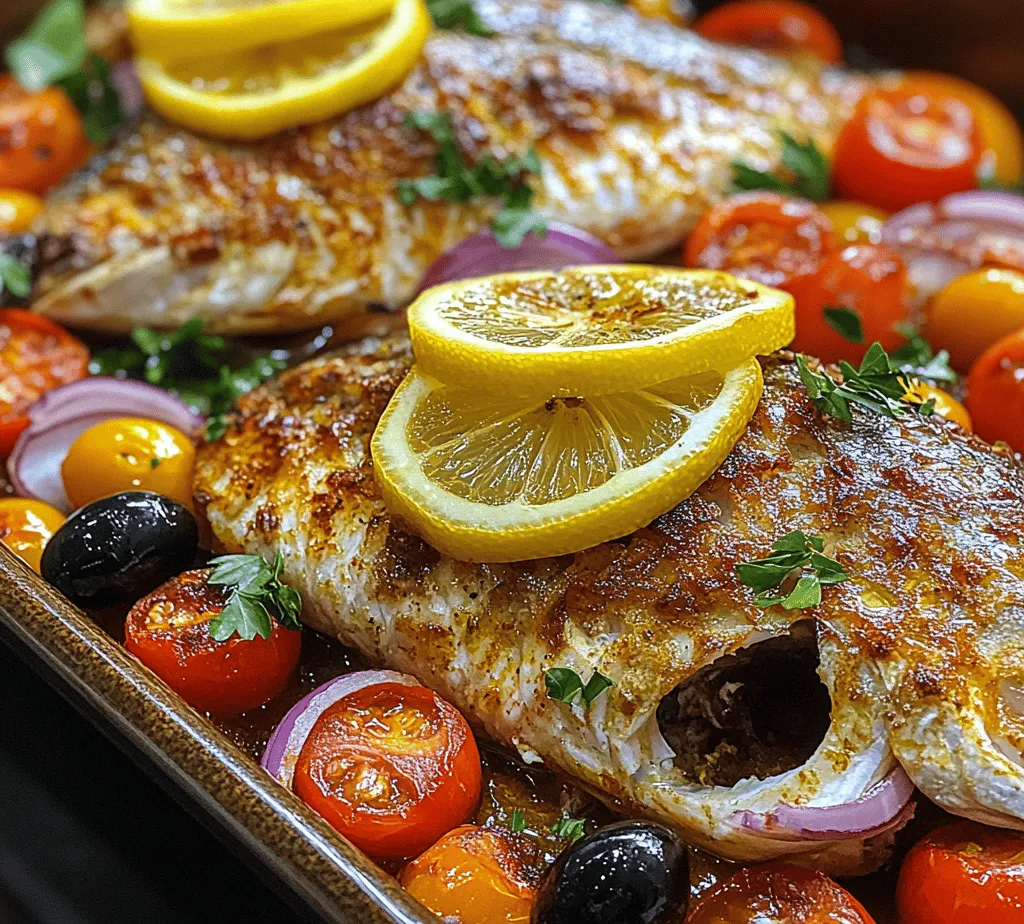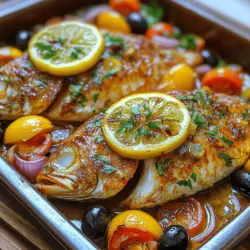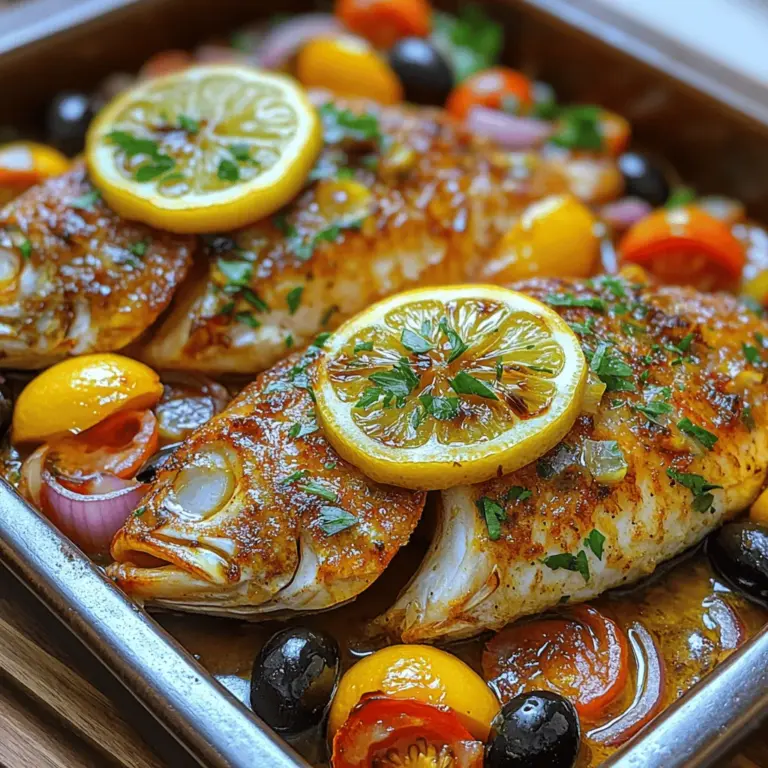Introduction
Mediterranean cuisine is a vibrant tapestry woven from the rich agricultural bounty of the region, boasting a diverse array of flavors, colors, and textures. Known for its emphasis on fresh, high-quality ingredients, this culinary tradition celebrates the use of seasonal produce, whole grains, and healthy fats, particularly olive oil. The Mediterranean diet is not only delicious but also heralded for its numerous health benefits, including heart health, weight management, and improved longevity. Among the many delightful dishes that embody these principles is the Mediterranean Baked Snapper, a quintessential recipe that perfectly captures the essence of this celebrated cuisine.
Whether it’s a busy weeknight or a festive family gathering, Mediterranean Baked Snapper shines as a versatile dish that brings the flavors of the coast right to your dining table. With its succulent, flaky flesh and zesty accompaniments, this dish is sure to impress both seasoned seafood lovers and newcomers alike. Perfectly balanced with the bright notes of citrus and the earthy undertones of fresh herbs, Mediterranean Baked Snapper invites you to embark on a flavorful journey that tantalizes the senses and nourishes the body.
The Allure of Snapper in Mediterranean Cooking
Snapper holds a revered place in Mediterranean diets, celebrated not just for its delicate, mild flavor but also for its remarkable nutritional profile. This fish is a rich source of high-quality protein, omega-3 fatty acids, and essential vitamins and minerals, making it a heart-healthy choice. The omega-3s found in snapper are known for their anti-inflammatory properties and their ability to support cognitive function, cardiovascular health, and overall well-being.
In addition to its health benefits, snapper’s versatility makes it a favored ingredient in Mediterranean cooking. Its firm texture allows it to hold up beautifully when baked, grilled, or sautéed, absorbing the flavors of surrounding ingredients while maintaining its integrity. This adaptability is particularly evident in dishes where snapper is paired with robust flavors like zesty lemons, aromatic garlic, and fragrant herbs.
Seafood, in general, plays a significant role in Mediterranean cultures, where it is often celebrated for its freshness and connection to the sea. The Mediterranean region is dotted with coastal communities that have relied on the ocean’s bounty for centuries, leading to a culinary tradition that prioritizes fish and shellfish as staples in the diet. By incorporating seafood into daily meals, these cultures promote a lifestyle rich in nutrients while simultaneously fostering a deep appreciation for the ocean’s resources.
Ingredients Breakdown
Creating a delicious Mediterranean Baked Snapper begins with high-quality ingredients. Each component not only enhances the flavor of the dish but also contributes to its overall nutritional value. Let’s take a closer look at the essential ingredients that come together to create this delightful meal.
Overview of Whole Snapper
Utilizing whole snapper is one of the key elements that elevates this dish. Whole fish brings a depth of flavor that fillets often lack, as cooking with the bones and skin imparts moisture and richness to the meat. When selecting a whole snapper, look for fresh, vibrant eyes, bright red gills, and shiny, reflective skin—indicators of freshness. Additionally, if possible, ask your fishmonger about the fish’s origin; sustainably sourced fish not only supports responsible fishing practices but also ensures you’re getting the best quality.
Olive Oil
Olive oil is a cornerstone of Mediterranean cooking, renowned for its heart-healthy properties and robust flavor profile. Rich in monounsaturated fats and antioxidants, olive oil has been linked to numerous health benefits, including reduced inflammation and improved cholesterol levels. Its versatility allows it to be used in a variety of cooking methods, from sautéing to drizzling over finished dishes. In this recipe, high-quality extra virgin olive oil is essential for enhancing the snapper’s flavor and ensuring a perfectly moist result.
Fresh Produce
The inclusion of fresh produce takes this dish to the next level, adding vibrant colors and complex flavors.
– Lemons: The zest and juice of lemons brighten the dish, providing a refreshing tang that complements the rich flavor of the snapper.
– Garlic: This aromatic ingredient adds depth and warmth, infusing the fish with its savory essence.
– Cherry Tomatoes: Their natural sweetness and juiciness create a delightful contrast to the savory elements of the dish.
– Red Onions: Providing a sharp yet sweet flavor, red onions contribute to the overall balance of tastes.
Olives and Herbs
No Mediterranean dish is complete without the inclusion of olives and aromatic herbs.
– Kalamata Olives: These dark, briny olives are a staple in Mediterranean cuisine, known for their rich flavor and firm texture. Their presence in the dish enhances the overall umami experience.
– Oregano and Thyme: These traditional Mediterranean herbs lend a fragrant, earthy quality to the recipe, perfectly complementing the flavors of the fish and vegetables.
Seasoning
The importance of seasoning cannot be overstated in any recipe. A simple yet effective combination of salt and pepper is essential for enhancing the natural flavors of the ingredients. Proper seasoning ensures that each bite is well-balanced and satisfying, amplifying the overall taste of the dish.
Preparation Steps
Preparing Mediterranean Baked Snapper is a straightforward process that yields impressive results. Follow these clear, step-by-step instructions to ensure a successful and delicious meal.
Preheating the Oven
Before you begin preparing the ingredients, preheat your oven to 400°F (200°C). Preheating is crucial for achieving the best cooking results, as it ensures that the fish cooks evenly and retains its moisture. A hot oven allows the snapper to roast beautifully, resulting in a flaky, tender texture.
Cleaning and Preparing the Snapper
To prepare the whole snapper, start by cleaning the fish. Rinse it under cold water to remove any residual scales and blood. If you’ve purchased a whole fish from a fishmonger, it should already be scaled and gutted, but it’s always a good idea to double-check. Pat the fish dry with paper towels to ensure that it crisps up nicely in the oven. Once cleaned, make a few diagonal slashes on each side of the fish. This technique helps the seasoning penetrate the flesh while allowing for even cooking.
Seasoning Techniques
With the snapper prepared, it’s time to season it. Generously sprinkle salt and pepper on the inside cavity and the outside of the fish. For added flavor, you can stuff the cavity with slices of lemon, garlic cloves, and fresh herbs. This method infuses the fish with aromatic flavors, creating a mouthwatering experience. Drizzle the entire fish with high-quality olive oil, ensuring that it’s well-coated. This step not only enhances the flavor but also helps to keep the fish moist during baking.
Preparing the Baking Dish
The baking dish plays a vital role in how the dish comes together. Choose a large, shallow roasting pan or baking dish to allow for even cooking. Begin by layering the bottom of the dish with sliced red onions and cherry tomatoes. This vegetable base not only provides a flavorful bed for the fish but also absorbs the drippings, creating a delicious sauce that can be served alongside the snapper.
As you layer the vegetables, arrange the seasoned snapper on top, making sure it sits comfortably without overlapping. This presentation ensures that the fish cooks evenly and showcases its beautiful colors and presentation when served.
Baking the Snapper to Perfection
Once your snapper is prepared and arranged in the baking dish, it’s time for the final step: baking. Place the dish in the preheated oven and allow the snapper to bake for approximately 25-30 minutes, depending on the size of the fish. During this time, the snapper will cook through, becoming tender and flaky while the vegetables caramelize and develop a delicious depth of flavor.
To ensure the fish is cooked through, you can check for doneness by gently inserting a fork into the thickest part of the flesh. It should flake easily and appear opaque. If needed, you can return it to the oven for an additional few minutes, but be careful not to overcook the fish, as it can become dry.
As the snapper bakes, the kitchen will fill with the enticing aromas of Mediterranean herbs and roasted vegetables, setting the stage for a delightful meal. The combination of flavors and textures will transport you to the sun-soaked coasts of the Mediterranean, making this recipe a must-try for seafood enthusiasts and home cooks alike.
Stay tuned for the next part of this Mediterranean Baked Snapper exploration, where we’ll discuss serving suggestions, variations, and tips for achieving the best results with this delectable dish.

When preparing Mediterranean Baked Snapper, there are several key techniques and considerations to ensure that your dish turns out perfectly. One significant step is covering the dish with foil during the initial baking phase. This method plays a crucial role in moisture retention, allowing the fish to steam gently in its own juices while absorbing the flavors of the herbs and vegetables. The foil traps heat and moisture inside the baking dish, creating an ideal environment for the snapper to cook evenly without drying out.
Once the snapper has been baking for a while, it’s essential to check for doneness. The fish should be opaque and flake easily with a fork. A reliable way to assess the doneness is to insert a fork into the thickest part of the fillet; if it flakes apart without resistance, it’s ready to be taken out. The perfect flaky texture not only enhances the eating experience but also reflects proper cooking techniques.
In the final stages of baking, removing the foil is critical for achieving that golden-brown top. This browning step not only enhances the visual appeal of the dish, making it more enticing on the plate, but it also develops a deeper flavor profile through caramelization. As the top of the fish browns, the sugars in the vegetables can also caramelize, adding a delightful sweetness that balances the savory elements of the dish.
Serving Suggestions
When it comes to serving your Mediterranean Baked Snapper, consider pairing it with accompaniments that will complement the flavors while adding variety to the meal. Crusty bread is a classic choice, perfect for mopping up the delicious juices from the baking dish. Alternatively, serving the snapper over a bed of fluffy couscous or steamed rice can absorb the flavors and provide a hearty base for the fish.
For an appealing table setting, consider garnishing the dish with fresh herbs like parsley or dill, and a sprinkle of lemon zest for a pop of color. Serving the snapper family-style on a large platter can encourage a communal dining experience, reflecting the Mediterranean tradition of sharing meals.
Wine pairing is another delightful aspect of serving this dish. A crisp white wine such as Sauvignon Blanc or a light-bodied red like Pinot Noir can beautifully complement the flavors of the snapper. Additionally, a side salad with arugula, cherry tomatoes, and a lemon vinaigrette can provide a refreshing contrast to the richness of the baked fish.
Health Benefits of Mediterranean Baked Snapper
The health benefits of Mediterranean Baked Snapper are numerous, making it an excellent choice for a nutritious meal. Snapper is a lean fish rich in high-quality protein and low in calories, making it heart-healthy. Moreover, snapper is an excellent source of omega-3 fatty acids, which have been linked to numerous health benefits, including reduced inflammation, improved heart health, and enhanced brain function.
In addition to the fish, the incorporation of olive oil, fresh vegetables, and herbs adds to the nutritional profile of this dish. Olive oil is known for its heart-healthy monounsaturated fats, which can help lower bad cholesterol levels. Fresh vegetables like tomatoes, bell peppers, and onions contribute essential vitamins and minerals, while herbs add flavor without the need for added salt or sugar.
The Mediterranean diet is widely recognized for its health benefits, including promoting longevity and reducing the risk of chronic diseases. By embracing whole foods, healthy fats, and a variety of plant-based ingredients, this diet supports overall wellness and vitality.
Cultural Significance of the Dish
Mediterranean Baked Snapper is not just a meal; it is a dish steeped in cultural significance. Originating from the coastal regions of the Mediterranean, fish has long been a staple in local cuisines, celebrated for its freshness and availability. Traditional cooking methods such as grilling, baking, and poaching have been passed down through generations, showcasing the region’s rich culinary heritage.
In Mediterranean cultures, sharing meals is a cherished tradition. Dishes like baked snapper are often served at family gatherings and celebrations, bringing people together over a shared love of food and community. This communal aspect of dining emphasizes the importance of relationships and connection, making each meal a special occasion.
Variations of baked snapper can be found across different Mediterranean countries, each bringing its unique twist to the dish. In Italy, you might find it flavored with capers and olives, while Greek versions often include feta cheese and lemon. These regional adaptations highlight the versatility of the dish and its ability to reflect local ingredients and cooking styles.
Conclusion
Mediterranean Baked Snapper is a dish that encapsulates the essence of Mediterranean cuisine: delicious, healthy, and culturally rich. The techniques used in preparing this dish, from moisture retention with foil to achieving that perfect flaky texture, ensure that it delights the palate with every bite. The thoughtful serving suggestions enhance the dining experience, making it a versatile option for both casual family dinners and special occasions.
As you embrace the flavors and health benefits of Mediterranean Baked Snapper, consider exploring more of the Mediterranean diet’s offerings. With its focus on fresh, wholesome ingredients, this culinary tradition not only nourishes the body but also fosters a sense of community and connection. By bringing the warmth of Mediterranean cooking into your kitchen, you can create memorable meals that celebrate the joy of togetherness around the dining table.

